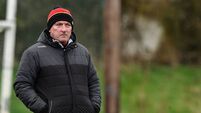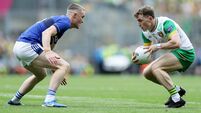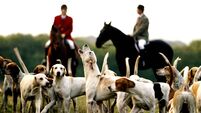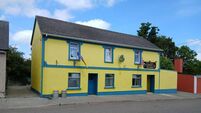Paul Rouse: Cavan's struggle for relevance shows GAA cannot be complacent about its future

GREAT LEAP: Thomas Galligan of Cavan during the Tailteann Cup Final match between Cavan and Westmeath at Croke Park in Dublin. Photo by Stephen McCarthy/Sportsfile
Next weekend the John Joe O'Reilly Memorial Committee is unveiling a statue to John Joe, Cavan's All-Ireland winning captain of 1947 and 1948, in Cavan town.
John Joe O'Reilly, one of the greatest footballers ever to play the game, died at just 34 years of age; he is a true icon of a period of dominance which saw Cavan win five All-Ireland senior football titles in the middle decades of the 20th century.
The erection of the statue to O’Reilly is a reminder of the importance of Cavan as a footballing county.
There was a brilliant bit of journalism recently by Paul Fitzpatrick in newspaper. It asked the provocative question: “Is Cavan still ‘a football county’?”
On the face of it, this was an extraordinary question to ask. Firstly, for all the bits of progress, Cavan is clearly not ‘a hurling county’? Secondly, it has neither professional or semi-professional soccer or rugby teams, so the GAA holds pride of place. Thirdly, it has the most distinguished history of any county in Ulster GAA.
A quick look at that history reveals just how distinguished it is.
The first official GAA event to be staged in Ulster was organised by the newly-formed Ballyconnell Joe Biggars. Biggar was actually a Belfast man, who was elected as a nationalist MP for Cavan in December 1885. The club affiliated to the GAA by March 1886 and in April 1886 it staged a sports meeting in Ballyconnell. Later, when other clubs attempted to claim the title of being the oldest club in Ulster, Ballyconnell simply changed their name to Ballyconnell First Ulsters. - this club is now called Kildallan and has been in the junior ranks for some forty years. This, in itself, is indicative of the struggles in west Cavan.
As well as being the first, Cavan footballers were also the best. They won 7 Ulster senior football titles in the 1920s, 8 in the 1930s and 9 in the 1940s. Indeed, from the beginning of World War I to the end of World War II, the only other team to win an Ulster senior football championship was Monaghan. There was decline thereafter with just three titles harvested in the 1950s and 4 in the 1960s, but that decline was relative only to the unprecedented scale of success which had come before.
Nonetheless, the four Ulster titles in the 1960s (1962,1964, 1967 and 1969 saw Cavan beat Down in each of those finals and they stand regarded as one of the best teams not to win an All-Ireland.
In general, success came more slowly at All-Ireland level, but championships were won in 1933, 1935, 1947, 1948 and 1952. By this point, Cavan were considered second only to Kerry in terms of pre-eminence in Gaelic football.
That all this success was achieved was in many respects something of a minor miracle. After all, the population of Cavan was low – fewer than 80,000 people lived there by the time of the first All-Ireland success – and falling still lower throughout the decades of greatest triumphs. Decade after decade people flowed from the land of this predominantly agricultural county, to the point where from a population of more than 240,000 on the eve of the Famine, just 54,000 people lived in Cavan in 1966.
The success of Cavan football was rooted in the clubs of its heartlands. They produced generation after generation of exceptional talents.
But the fact is that it could not sustain that success. Firstly, clubs from the county – who had once set a high benchmark – made limited progress and no Cavan club has won the Ulster club championship since its inauguration in 1968.
And then, from 1970 to 1996 Cavan did not win a single Ulster senior football championship. They did indeed win one in 1997 – and won again in 2020 in an epic Ulster final against Tyrone, played out in Covid Ireland.
But there is no doubting that now the power of football in Ulster lies north of Cavan.
Which brings me back to Paul Fitzpatrick’s article. Referring to Gaelic football, he wrote: “I wonder about the pre-eminence of the sport in Cavan, town and county, these days. For the longest time, Gaelic football had things all its own way in this county. This is not really horsey country; no Sheikh or stock market tycoon is going to risk his prize assets among the drumlins, where the land has been described as basket of eggs, all hills and at the bottom of them, mainly water. Eggs break and so do horses.
“Hurling? It’s barely a rumour. Traditionally, there have been a handful of established soccer clubs; others came and went. A few have their own permanent pitches or clubhouses. There are minority pursuits like boxing and handball, which have produced champions and a couple of strong athletics clubs, although athletes from the county town must travel half an hour to train on a track. There are two rugby clubs in the county, both founded in the 1970s, and a strong motor club. Basketball has a solid foundation and is on the rise. But Gaelic football has always been the thing. Around here, the word ‘Gaelic’ is superfluous. That blasphemous word ‘Gah’, I didn’t even hear until I was 19 and in college.”
And yet, while Gaelic football “has always been the thing”, Fitzpatrick writes: “Many clubs are struggling to field teams on their own at underage level and even adult level in some cases. There are half as many actual teams entered in Under 16 football now as there were 25 years ago, at a time when there were less than half as many children as now living in the county. In real terms, that’s a collapse.”
Why has this happened? After all, the most recent census has shown that the population of Cavan is growing and growing. Indeed, it is has increased by 60% from its lowest point.
But what Cavan shows is that population growth in itself is not going to grow the GAA. Indeed, it presents real challenges to the Association.
For example, in Cavan the population growth is rooted in the area of the county close to the Meath border. This needs to be harnessed if Cavan is to prosper.
There is also a central corridor of the county that runs along the N3 (more or less) from Virginia down to Cavan town which has also increased its population. This has allowed for positive development. Killygarry, for example, is on the outskirts of Cavan Town and now has over 600 juveniles, boys and girls. It used to be a small country club, but this year its teams made the men's and ladies senior football finals, the minor football Division 1 final, the Under 15 and Under 13 Division 1 finals.
But harnessing population changes is not simple. Rural Ireland is a much-changed place in a new millennium. There are many diverse opportunities for its children. The spread of different types of sport, the sheer range of non-sporting leisure activities, the unravelling of all the old verities which tied people to place by tradition have been loosened or lost or – in the case of new arrivals – never existed.
In Virginia, for example, there is now a top-class basketball club (they have a women's team in National League with American imports, etc.) and a rugby club competing with the best in Ulster at underage level, as well as a soccer club. This is a big change in two decades.
What is clear, of course, is that the challenge facing Cavan is one that is repeated in many other counties across the island. The answers to the challenge are to be found in concerted local and national endeavours and a level of planning and initiatives that have not even been conceived of, let alone implemented.
There is a hint of complacency about the way the GAA thinks of its future. That is never a good thing for any institution.








